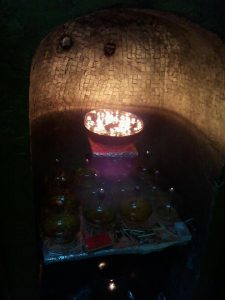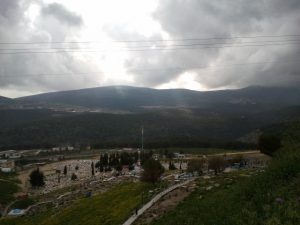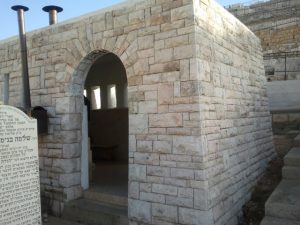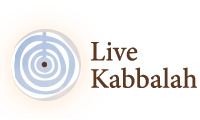Lesson 1 – Part B
The Golden Age of Jewish Mysticism at the End of the Second Temple Period
Kabbalah and Jewish mysticism thrived and grew in popularity, at the end of the Second Temple Period, about 1,500 years after Abraham the Patriarch (some 2,000 years ago). Evidence of this can be found in the Dead Sea Scrolls, and also in the Midrash and the Talmud. This is the time during which the great Rabbi Shimon Bar Yohai lived. It is also a time when Judaism became much more than just a religion or a body of laws to follow (Halakha). It became a way of life that was very popular among Jews and non Jews alike, throughout the Roman Empire. Stories in the Talmud share how this ancient wisdom became, a phenomenon whereby members of the world’s nations would ask advice and guidance from the Jewish sages who lived among them.
Writing of the Zohar and Lag Ba’Omer

Meiron – The entrance to Rabbi Shimon’s burial cave.
The great Rabbi Shimon Bar Yohai, author of the Zohar (the most important book of Kabbalah), lived in Israel during the 2nd century C.E. To this day, his death anniversary is being celebrated, especially in Israel, to commemorate the incredible power of the Zohar, which he revealed to the world. According to the Zohar, Rabbi Shimon Bar Yohai knew he was going to leave the world on that day, so he assembled his closest friends and students and told them he was planning on leaving the world. However, before he left, he had to finish the creation of the Zohar. So his friends surrounded him and Rabbi Shimon dictated the final chapter of theZohar during his remaining hours. Legend says that during his last hours on earth, fire surrounded the house that did not allow anyone to enter except the people closest to Rabbi Shimon.
According to Rabbi Aba (who wrote down Rabbi Shimon’s last words), the last word Rabbi Shimon dictated before he died was, “Haim” (life). His soul departed shortly after and a smile was left on his face. Soon after, a huge crowd gathered around the house from the surrounding towns of Meiron and Tsipori. An argument broke out amongst the gathered, about where Rabbi Shimon was to be buried. Suddenly, Rabbi Shimon’s bed arose in the air and flew out of the house with everyone following. It stopped at an entrance to a cave that was blocked by a wall of fire. At that moment a Bat Kol (A heavenly voice) announced that this cave will be the burial place of Rabbi Shimon and invited everyone to celebrate his ascending to heaven. Since then, every year on Lag Ba’Omer (the death anniversary of Rabbi Shimon), it is a tradition to light a bonfire in memory of the fire surrounding Rabbi Shimon’s house as he completed writing the Zohar (followed today mainly by Israeli children).
The Discovery of the Zohar in Spain
According to tradition, the Zohar was hidden for many years until it was discovered in Spain in 1270 C.E. by Rabbi Moshe DeLeon (although there are some evidences for earlier texts of the Zohar). In a few short years the Zohar reached almost every Jewish community around the world (Europe, Central Asia, Yemen, India, North Africa, etc.). Due to its incredible spiritual power it impacted and influenced Jewish Law (Halakha), prayers, customs, philosophy and theology. Even though the Zohar was being distributed worldwide, it was accompanied by a decree on teaching it to the lay person. There was a fear and a concern that not everyone could be exposed to this ancient wisdom without being damaged by the intensity of the teachings. The rational was that, it was quite possible, that one might understand things the wrong way and use the wisdom inappropriately.
Golden Age of Tsefat and its Kabbalists

Safed (Tsefat) – The Old Cemetery
Kabbalah re-emerges once more, revitalized and re-invented, 250 years later, in the 16th century in the mystical city of Tsefat, Israel. This Renaissance happened, mainly thanks to the great Masters of Kabbalah; Rabbi Moshe Cordovero, The Holy Ari (Rabbi Yitshak Luria Ashkenazi), Rabbi Haim Vital and many more. For the first time, due to an abundance of books on the subject of Kabbalah, being published and available to the general populace, Kabbalah became user friendly. In addition to studying and learning Jewish Law (Halakha), Torah and Talmud, people could read books on Kabbalah that significantly helped to improve their daily lives. People were excitedly reading books dealing with; reincarnation, meditation, cosmology and studying the creation of the Universe and its secrets. The most famous and known authors of Kabbalistic literature during this time was The Holy Ari – Rabbi Yits’hak Luria.
The Decree on Studying Kabbalah and the Zohar is Lifted
Kabbalah continued to increase in popularity and the Kabbalists came to the conclusion, that from the beginning of the 16th Century, there is no longer any danger in studying Kabbalah. On the contrary, the very survival of the Torah study, faith and values depends on us studying Kabbalah as the continued existence of the Torah and Judaism depends on the soul and spirituality that Kabbalah imbues in them. Consequently, the decree and shroud of secrecy that had surrounded the study of Kabbalah had been lifted and people could openly benefit from this wisdom that had the potential to bring fulfillment, health, wealth, divine inspiration and joy to their lives.
The phenomenon of Kabbalah spread to the entire Jewish world and branched into two major schools in the modern age – the Sefardic Kabbalah and the Hassidic movement of Eastern Europe. Both were based on the writings of Tsefat’s Kabbalists of the 16th Century and mainly on the Ari’s writings.
The founder of the Hasidic movement was the Ba’al Shem Tov and its disciples established Habad, Breslev and the rest of Eastern European Hasidic movements. Amongst the Sefardic Kabbalists, the most familiar are; Rabbi Haim Ben Atar, Rabbi Abraham Azulai, RAMHAL (Rabbi Moshe Haim Lutsato), RASHASH (Rabbi Shalom Sharaabi), The Ben Ish Hai and many more.
From the beginning there was a free flow of ideas between the two movements and their followers, till this day.
Rabbi Ashlag – Initiator of Kabbalah’s Modern Revolution

Jerusalem, Har HaMenuhot – Rabbi Ashlag’s Grave site
Early in the 20th Century, Sephardic Judaism and Hasidism went through a process whereby once more Kabbalah was pushed into the background and it was thought that this ancient wisdom would be once more lost to the world. As a result of this process, traditional Judaism turned into a “dry”, mechanical, robotic experience that had lost its soul. Rabbi Ashlag arrived on the scene in 1922, in Jerusalem, and initiated a revolution whose waves are still felt today. For the first time in Kabbalah’s history, Rabbi Ashlag made Kabbalah accessible and available for everyone to study. In his writings he says that he found a great need to blow the iron barrier that stood between Kabbalah and the people, a barrier that had existed since the destruction of the Temple. He no longer wanted to live in the fear that Kabbalah could once more be hidden and forgotten for another generation. The time had come to bust things wide open. At the same time, another person arrived in Israel and his name was Gershom Scholem. He too feared the possibility that Kabbalah could disappear yet again, so he opened the Department of Kabbalah at the Hebrew University and became the founder of the Modern Academic Study of Kabbalah.
The monumental life’s work of Rabbi Ashlag includes a translation of the Zohar from Aramaic to Hebrew. It has the most comprehensive interpretation which allows us, the students, to understand in today’s language, the remarkable order and consistency that exists in the Universe, its rules and how and why they exist, for the sole purpose of granting us a life of utter and complete fulfillment. It is also remarkable to see the symbiotic relationship and interconnectedness between the Zohar and other major bodies of Jewish literature such as the Talmud, Torah, Midrash, Halakha, etc. In addition, Rabbi Ashlag wrote commentaries on all of the Ari’s important writings and he wrote and compiled an incredible group of essays that synthesized Kabbalah and its connection to the greatest modern and scientific disciplines, such as Quantum Physics, Modern Medicine, Psychology and more.
Rabbi Ashlag passed away on Yom Kippur 1954, and his legacy of revealing Kabbalah to the world in a way that the lay person could use and relate to, will never be forgotten. His followers have continued to publish and encourage the widespread dissemination of Kabbalah. He is directly responsible for the mass movement of studying Kabbalah in the whole world today, a phenomenon that was seen only during the time of Rabbi Shimon Bar Yohai.
Rabbi Ashlag followed the huge footsteps of Rabbi Shimon Bar Yohai, and today, men and women can study Kabbalah and benefit from it in so many different, positive and exciting ways thanks to his efforts.
Rabbi Ashlag’s Doctrine can be extracted to a few principles:
- The Universe is an organized flawless world, in which understanding and knowing the rules that make it move, can be available to everyone.
- Studying Kabbalah can bring everyone closer to fulfilling their life’s purpose – A life of happiness, joy, spiritual “high” and satisfaction.
- In order to achieve a life of happiness and perfection without experiencing pain and suffering, we have to connect to the Creator’s Light. This could happen only when we learn to love our fellow man with unconditional love. Therefore, the supreme value in every person’s life, is altruism and respecting every human being and treating one another with human dignity. In other words, altruism is not a moral, social, religious or rational value, but a tool and means that is the most rewarding, beneficial and practical.
- Practicing altruism by this method will bring the person and the whole society to an era in which anguish and suffering will be eradicated forever.
We can see here a tangible expression of the revolutionary message of Abraham the Patriarch, the same message that influenced the history of mankind more than any other message; the message that praised the fact, that every person is created in the image of The Creator, and therefore he is entitled to human dignity and happiness; A message in which Rabbi Akiva well expressed: “Love your fellow man as you would love yourself” (Leviticus 19:18) is the main and inclusive rule in the understanding of the Bible and it’s rules.
For additional study please enter the course “Level 1 – The Inner World of the Kabbalist” at Live Kabbalah University.
Lesson 1
Part A
What is Kabbalah?
Part B
The Zohar through History
Part C
Kabbalah’s Influence on the Development of Modern Science
Lesson 2
Reality and Illusion, the True World (Olam HaEmet) vs. The False Reality of the bodily senses and mind.
The Language of Branches – The Special Language of the Kabbalists
The Desire and its Fulfillment
Part A
The Rules of Life
Part B
The Way to Happiness
Part C
Logic as a Barrier
Lesson 3
How did it all begin? The Creation of the Universe, The Source of all Souls, What is every Soul made of?
The Big Bang Theory vs. Rabbi Isaac Luria’s Tsimtsum Theory.
What is the source of Evil in this world? The real motivation of the soul vs. Maslow’s Hierarchy of Needs
Part A
Where do we come from?
Part B
Being a Creator
Lesson 4
Good and Evil, Good Inclination and Evil Inclination: Duality as the Source for the Meaning of Life. Free Will: Logic vs. Faith.
Lesson 5
The Tikun doctrine: How everyday’s life is a mirror of the journey the soul is taking. Why do bad things happen to Good People? The Rules of Cause and Effect, Reincarnation in Kabbalistic Teachings.
Lesson 6
Being a Creator – How to understand feelings and emotions? How can we tell between good and evil? The guidance to define negative emotions and the way to transform them.
Lesson 7
Tools for spiritual change:
- Our community.
- The Hebrew letters as an expression of hidden cosmic forces and invisible frequencies – the building blocks of our reality. The marvelous story of the 72 names of the Creator through the unofficial history of the world.
Lesson 8
Basics in Kabbalistic Meditations.
The Name of 42 Letters, The “Ana VeKho’ah” – one of the major holy metitation in the Jewish mystical world.
Lesson 9
“Ets Ha’Haim” – The Tree of Life, Sefirot and Olamot (Worlds).
How is it that The Creator never changes but it looks like He does?
The Cosmology of Good & Evil
The Tetragrammaton.
Lesson 10
The Myths of Messiah, Resurrection of the Dead and the Hebrew Calendar. Prophets of the end of days according to the Kabbalah and the ability to differ between false believes and a guidance to a better future.
To listen to the lessons above, please enter :Live Kabbalah University.
